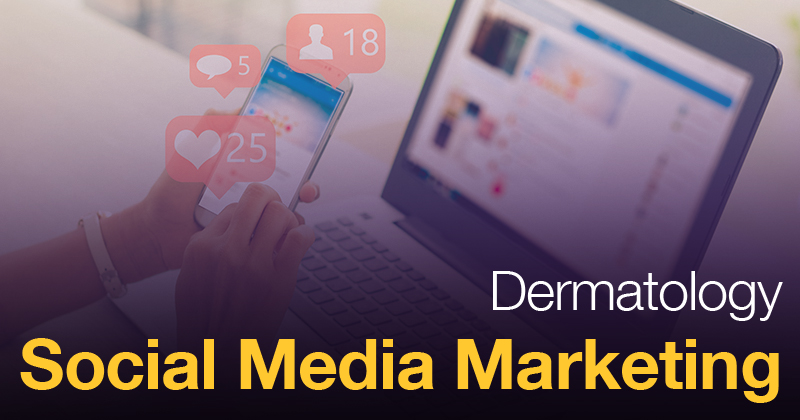How Can You Reach Dermatology Patients With Social Media?

Here’s how you can use social media to help inform and attract current and future patients to your dermatology practice.
 According to a report from GWI, internet users on average spend about 142 minutes a day on social networking and messaging sites. That means that almost two and a half hours exist each and every day for your dermatology practice to be one of the many profiles patients see. Facebook, Twitter, Instagram, Snapchat and LinkedIn, among others, provide essentially free marketing platforms to educate your current patient base and reach prospective patients, too. Social media in healthcare, as well as the role and influence it holds, has grown greatly over the years and shows no signs of slowing down.
According to a report from GWI, internet users on average spend about 142 minutes a day on social networking and messaging sites. That means that almost two and a half hours exist each and every day for your dermatology practice to be one of the many profiles patients see. Facebook, Twitter, Instagram, Snapchat and LinkedIn, among others, provide essentially free marketing platforms to educate your current patient base and reach prospective patients, too. Social media in healthcare, as well as the role and influence it holds, has grown greatly over the years and shows no signs of slowing down.
Benefits of Social Media for Your Dermatology Practice
 Let’s first take a look at the varied benefits of a social media presence for your practice. In addition to using search engines, patients now search and find information on individual social platforms. Potential patients could easily find you on Facebook based on a post that was shared or pages their network of “friends” like. As a result, your profile should provide easy access to your direct content information. Prospective patients will do their due diligence and want to research you, and social media has now become one of the many websites they will end up on. Social media can help build your brand integrity and awareness. Perhaps your practice focuses on cancer care or more cosmetic options. Either way, you can use your social media profiles to illustrate these areas of specialization.
Let’s first take a look at the varied benefits of a social media presence for your practice. In addition to using search engines, patients now search and find information on individual social platforms. Potential patients could easily find you on Facebook based on a post that was shared or pages their network of “friends” like. As a result, your profile should provide easy access to your direct content information. Prospective patients will do their due diligence and want to research you, and social media has now become one of the many websites they will end up on. Social media can help build your brand integrity and awareness. Perhaps your practice focuses on cancer care or more cosmetic options. Either way, you can use your social media profiles to illustrate these areas of specialization.
As a physician, I feel that part of my duty is to help educate patients, and social media can provide a great outlet to do so. While you want to avoid providing medical advice or treatment, you want to present yourself as a trusted thought leader in the space, and bring awareness to commonly treated skin conditions and other services you provide at your practice.
 In addition, giving back to the community has become increasingly important in consumers’ decision-making processes. And social media is a great place to share how you and your staff give back. That could include posting photos of your involvement in sponsoring an area sports league or providing care to underserved populations. It can help amplify your practice’s image and serve as a very powerful tool, especially in tandem with a strong website and other digital marketing and public relations efforts.
In addition, giving back to the community has become increasingly important in consumers’ decision-making processes. And social media is a great place to share how you and your staff give back. That could include posting photos of your involvement in sponsoring an area sports league or providing care to underserved populations. It can help amplify your practice’s image and serve as a very powerful tool, especially in tandem with a strong website and other digital marketing and public relations efforts.
The underlying goal of social media lies in creating a sense of a digital community and connecting those whom you may or may not ever meet in person. You want to do what you can to become a part of that community, both as a dermatologist and as a practice, and humanize aspects of your practice. A social media presence where you control the story is a key facet to public perception.
How to Reach Patients With Social Media
 Step one involves creating and claiming your social media profiles. However, just because a platform exists, it doesn’t mean you must create a social profile on it. Posting and maintaining an updated and engaging profile may take more time than you initially think, so it’s better to pinpoint the one or two channels that will work best for you and expand from there based on bandwidth. You want to create engaging content that benefits your audience in some way.
Step one involves creating and claiming your social media profiles. However, just because a platform exists, it doesn’t mean you must create a social profile on it. Posting and maintaining an updated and engaging profile may take more time than you initially think, so it’s better to pinpoint the one or two channels that will work best for you and expand from there based on bandwidth. You want to create engaging content that benefits your audience in some way.
On Facebook, you need to first have a personal profile to set up a business page. You can then invite your current “friends” to like your new page and encourage staff to do the same to start to grow your fan base. Signage in the office, links on your website and emails to patients can all include the social media platforms you have profiles on to start building your audience.
Dermatology is a very visual medical field, and the cosmetic side of the practice can certainly provide some great imagery. Posting photos of before and afters (adhering to HIPAA regulations, of course) of treatments you offer may work wonders to help market your practice and expertise. It showcases positive results while piquing the interest of patients—both current and future ones—who find these images on your social media profiles. Let your social media profile tell an engaging story about you, your staff, your practice and your patients.
You want to show that your practice is comprised of personable, knowledgeable experts. Sharing content such as staff Q&As, fun photos from around the office, celebratory milestones, skin care products offered—all these convey an image. Sharing patient testimonials (again, adhering to HIPAA regulations) can help influence a prospective patient’s view of your practice. It may even help them decide if they should pick up the phone to schedule an appointment. You want to create shareable content and encourage your staff to share posts, too.
As mentioned earlier, social media serves as another avenue to provide patient education. Sun safety tips, different types of facials, various laser treatments, home remedies and even debunking common skincare myths can all lend themselves to great topics to share information on. Just like your dermatology electronic health record (EHR) system should provide patient education handouts during an exam, you can further this educational reach via digital methods.
If you have a blog on your website—which I would highly encourage—you can use the links from blog content to populate social media content. This can help drive more individuals to your website, increase brand awareness and showcase you as an authority on the topic. Providing such resources can help to further establish you as a trusted thought leader, and it could sway someone to select you versus a competitor in the same community.
 In the digital space, video content reigns supreme. You don’t need a fancy setup and can simply record short clips of you and your staff in the office. Ideas for videos could including showcasing the benefits of a new product line, demonstrating a procedure (again, avoid PHI or violating HIPAA rules) or briefly discussing sunscreen protection for kids on spring break. The opportunities are endless, and on social media, oftentimes the least edited and most “real” videos can garner the most attention.
In the digital space, video content reigns supreme. You don’t need a fancy setup and can simply record short clips of you and your staff in the office. Ideas for videos could including showcasing the benefits of a new product line, demonstrating a procedure (again, avoid PHI or violating HIPAA rules) or briefly discussing sunscreen protection for kids on spring break. The opportunities are endless, and on social media, oftentimes the least edited and most “real” videos can garner the most attention.
Who doesn’t love a good promotion? Use social media to share specials on facial treatments, post news of upcoming in-office events and offer new patient incentives. These marketing tactics can help drum up visibility and make your practice that much more appealing to potential new patients.
Pay to Advertise Your Dermatology Practice
 While the social media platforms I’ve mentioned in this post are essentially free, they do offer paid advertising components as well. Let’s take Facebook, for example. Perhaps you just opened a new office and are interested in increasing awareness of your practice in the surrounding zip codes. You can set up a campaign to target individuals on Facebook based on various demographics and geographic locations to help drive traffic to your website, advertise a special offer on fillers or promote an upcoming event. It’s all about increasing awareness of your brand.
While the social media platforms I’ve mentioned in this post are essentially free, they do offer paid advertising components as well. Let’s take Facebook, for example. Perhaps you just opened a new office and are interested in increasing awareness of your practice in the surrounding zip codes. You can set up a campaign to target individuals on Facebook based on various demographics and geographic locations to help drive traffic to your website, advertise a special offer on fillers or promote an upcoming event. It’s all about increasing awareness of your brand.
The Role of Hashtags to Help Increase Your Dermatology Practice Visibility
 With the proliferation of digital media in our daily lives, it does become challenging to stand out from the crowd. One social media strategy, particularly on Instagram, includes the thoughtful use of hashtags. Hashtags essentially serve as interactive search terms for a variety of topics, and often, trending issues and world events can make them “go viral.” For instance, #dermatology on Instagram pulls up over 900,000 results. While you may still want to use that hashtag on your posts, it will be much more challenging to gain visibility to those searching for that term or clicking on that hashtag. However, #sunscreentips turned up under 500 posts, making it easier to stand out from the crowd. There is a trade-off as those with fewer posts are typically less searched so it’s finding a happy medium. You can use up to 30 hashtags on a single post, but I would suggest selecting the 5-6 that are most relevant to the post. It keeps your profile looking much more professional, too.
With the proliferation of digital media in our daily lives, it does become challenging to stand out from the crowd. One social media strategy, particularly on Instagram, includes the thoughtful use of hashtags. Hashtags essentially serve as interactive search terms for a variety of topics, and often, trending issues and world events can make them “go viral.” For instance, #dermatology on Instagram pulls up over 900,000 results. While you may still want to use that hashtag on your posts, it will be much more challenging to gain visibility to those searching for that term or clicking on that hashtag. However, #sunscreentips turned up under 500 posts, making it easier to stand out from the crowd. There is a trade-off as those with fewer posts are typically less searched so it’s finding a happy medium. You can use up to 30 hashtags on a single post, but I would suggest selecting the 5-6 that are most relevant to the post. It keeps your profile looking much more professional, too.
Use Social Media When Starting Your New Dermatology Practice
 Starting a new dermatology practice is quite the undertaking with so many factors to consider. Where should you open your doors? What kind of patients and treatments will you focus on? What resources will you need in your office? Resources can include anything from chairs in your waiting room to laser machines, medical equipment, office supplies and even dermatology software like an EHR and practice management system. One of the last tasks you may think of is marketing your new dermatology practice. With limited resources of both time and money during this time, you can use social media as a great jumping-off point for your marketing efforts. Compared to other marketing channels, it requires a lower investment of both time and funds.
Starting a new dermatology practice is quite the undertaking with so many factors to consider. Where should you open your doors? What kind of patients and treatments will you focus on? What resources will you need in your office? Resources can include anything from chairs in your waiting room to laser machines, medical equipment, office supplies and even dermatology software like an EHR and practice management system. One of the last tasks you may think of is marketing your new dermatology practice. With limited resources of both time and money during this time, you can use social media as a great jumping-off point for your marketing efforts. Compared to other marketing channels, it requires a lower investment of both time and funds.
Some Final Thoughts on the Role of Social Media in Healthcare
 According to the rule of seven, you’ll find that marketing is an ongoing process, and consumers have to see and recognize the item or service multiple times over before they take an action. Use yourself as an example. You probably don’t purchase the first car you test drive or select the first quote you get on a kitchen renovation, so the same applies when it comes to a patient selecting a dermatology practice. Social media should help facilitate a dialogue rather than being one-sided or focusing on a hard sell of your services. Those tactics will turn people off and are most likely not part of the brand you want to convey. You want your social media to benefit your audience—current and future patients—which can benefit your practice, too.
According to the rule of seven, you’ll find that marketing is an ongoing process, and consumers have to see and recognize the item or service multiple times over before they take an action. Use yourself as an example. You probably don’t purchase the first car you test drive or select the first quote you get on a kitchen renovation, so the same applies when it comes to a patient selecting a dermatology practice. Social media should help facilitate a dialogue rather than being one-sided or focusing on a hard sell of your services. Those tactics will turn people off and are most likely not part of the brand you want to convey. You want your social media to benefit your audience—current and future patients—which can benefit your practice, too.





